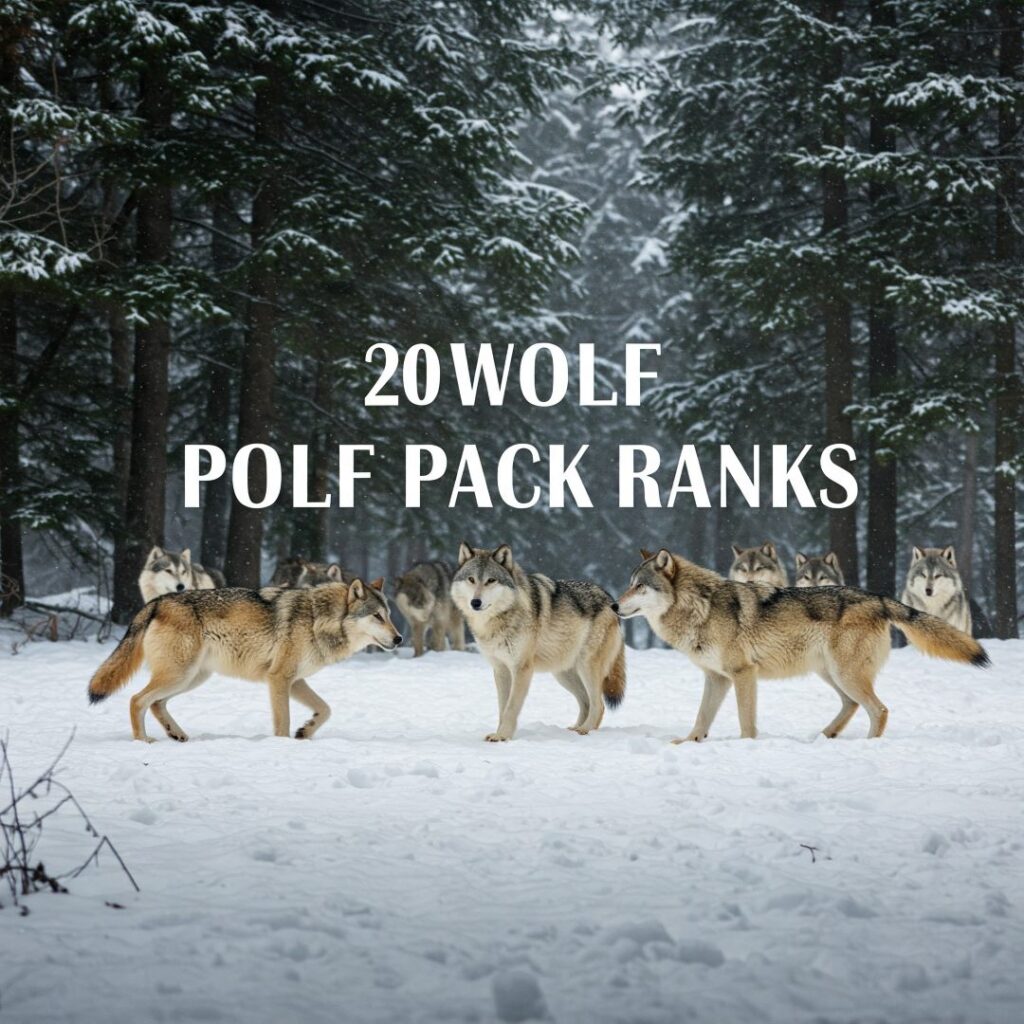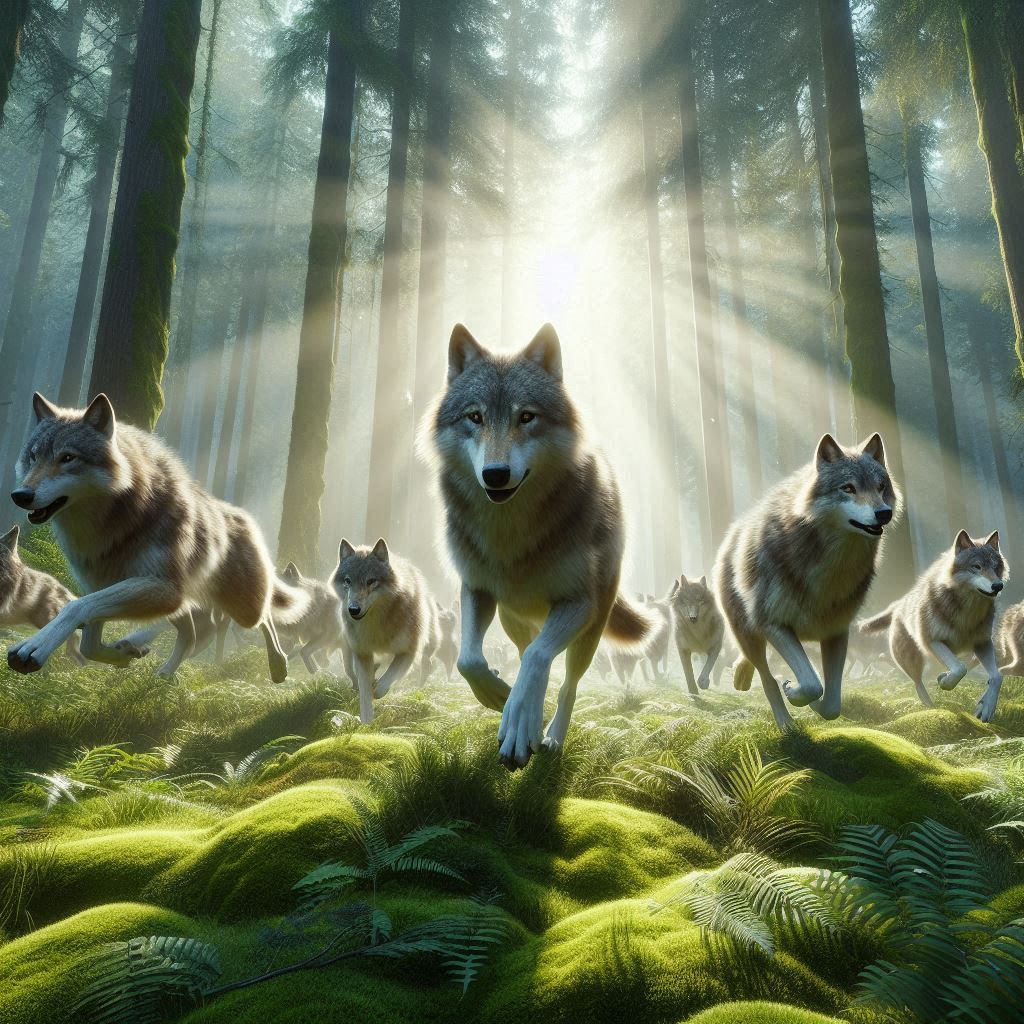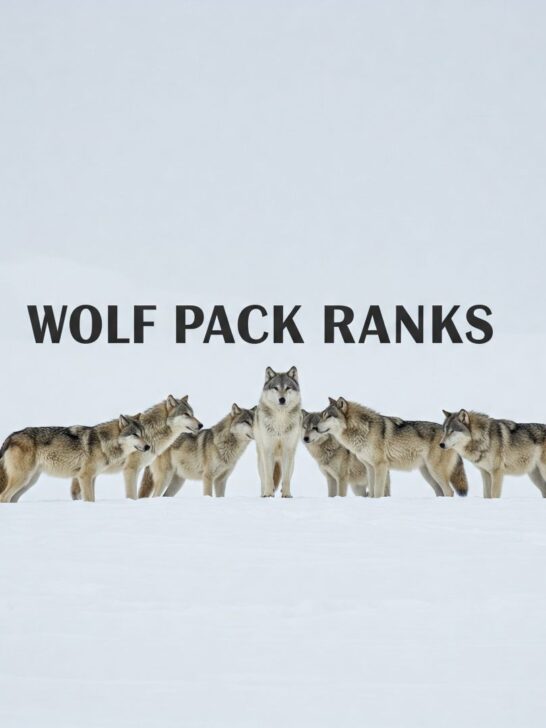Wolf packs are remarkable social structures where cooperation and hierarchy ensure survival in the wild. Each member plays a unique role, contributing to the overall success and stability of the pack. Below is a detailed breakdown of the ranks and responsibilities within a wolf pack:
here we have an extensive exploration of hypothetical ranks in a fictional wolf or werewolf pack, blending scientific observations with imaginative elements. It illustrates a highly stratified pack structure, where each rank fulfills specific roles to ensure survival, organization, and efficiency. Here’s a concise summary of the ranks and responsibilities described:
Post Contents
- The Alpha Male
- The Alpha Female
- The Beta Wolf
- The Delta Subordinate Wolf
- The Omega Wolf
- The Lone Wolf
- Key Aspects of Wolf Packs
- FAQ about wolf packs and ranks
- 1. What is a wolf pack?
- 2. What are the ranks in a wolf pack?
- 3. Are ranks in wolf packs fixed?
- 4. What role do Alphas play in a wolf pack?
- 5. What is the role of Omega wolves?
- 6. Do all wolves hunt in a pack?
- 7. How big is a typical wolf pack?
- 8. What happens when young wolves leave their pack?
- 9. How do wolves communicate within a pack?
- 10. Can a wolf challenge for leadership in a pack?
- 11. What is wolf pack mentality?
- 12. Why do wolves form packs instead of living alone?
- 13. Where does the leader of a wolf pack walk?
- 14. What makes wolves different from other social animals?
- 15. What is a wolf pack mentality?
- 16. Where does the leader of a wolf pack walk?
- Conclusion
High Ranks
Alpha
- Role: The Alpha is the supreme leader of the pack. They are responsible for maintaining order, enforcing rules, and ensuring the pack’s survival through strategic decision-making. They embody authority and command respect.
- Responsibilities: The Alpha sets the rules, leads hunts, directs movements, and protects the pack. They may banish or punish wolves that pose a threat to unity. While their dominance is rarely challenged, a successful challenger can overthrow them, causing significant shifts in the pack dynamic.
- Traits: Alphas are confident, dominant, and often display strength and wisdom. They serve as role models and guardians for the pack.
Beta
- Role: The Beta is the second-in-command, acting as a mediator and enforcer of rules in the Alpha’s absence. They are integral to maintaining order and may step into leadership if the Alpha is unable to fulfill their duties.
- Responsibilities: Betas ensure the pack’s daily activities run smoothly. They help resolve disputes, organize hunts, and oversee various tasks. In extraordinary circumstances, they may ascend to the Alpha role.
- Traits: Loyal and respected, Betas possess both leadership qualities and the ability to work collaboratively.
Sentinels
- Role: Sentinels act as the elite guards and potential successors to the Alpha and Beta. They are specially chosen by the leaders and trained to take over in emergencies.
- Responsibilities: Sentinels safeguard the pack and enforce rules when directed. They undergo rigorous training and represent the authority of the Alpha and Beta.
- Traits: Disciplined, trusted, and highly skilled, sentinels are held in high regard by the pack.
Elders/Gamma
- Role: Elders, often referred to as Gammas, provide wisdom and counsel based on decades of experience. They are typically older wolves who were once Alphas or held high ranks.
- Responsibilities: Elders advise the Alpha on important decisions, recount stories to preserve traditions, and mentor younger wolves. They are also revered as cultural and spiritual leaders within the pack.
- Traits: Wise, respected, and cherished, Elders embody the historical and moral backbone of the pack.
Zeta
- Role: The Zeta is the war general, leading the pack during conflicts and training wolves for combat.
- Responsibilities: They strategize defenses, lead battles, and train recruits for high-stakes missions. In times of peace, they focus on improving the pack’s preparedness.
- Traits: Tactical, strong, and decisive, the Zeta is an essential figure for the pack’s security.
Epsilon
- Role: The Epsilon serves as the guardian of the pack, overseeing its safety and repelling threats.
- Responsibilities: They patrol borders, ensure peace within the pack, and act as negotiators during disputes with rival packs. Their role requires skill in both diplomacy and combat.
- Traits: Brave, alert, and protective, Epsilons balance strength with restraint.
Delta
- Role: Delta wolves serve as messengers, facilitating communication between the pack and external allies or rival groups.
- Responsibilities: They convey critical information, negotiate terms, and maintain peace between groups when possible. Their tasks often involve risk and require sharp instincts.
- Traits: Agile, resourceful, and composed under pressure, Deltas are key players in diplomacy and communication.
Assassin
- Role: Assassins are the stealth operators of the pack, tasked with espionage and eliminating threats.
- Responsibilities: They gather intelligence, infiltrate rival territories, and execute critical missions to protect the pack.
- Traits: Stealthy, skilled, and strategic, assassins work discreetly but play vital roles in high-risk situations.
Low Ranks
Lead Warrior
- Role: The Lead Warrior directs the pack’s warriors and ensures successful defense against threats.
- Responsibilities: They take orders from the Alpha and coordinate patrols, guards, and combat readiness among warriors.
- Traits: Commanding, courageous, and resourceful, Lead Warriors inspire and protect the pack.
Theta
- Role: The Theta is the lead medic, responsible for the pack’s health and well-being.
- Responsibilities: They assist with healing wounds, aiding childbirth, and providing medical care during wars and hunts.
- Traits: Knowledgeable, nurturing, and dedicated, Thetas are respected caregivers in the pack.
Warrior/Eta
- Role: Warriors serve as the pack’s protectors and ensure its safety by patrolling territories and responding to threats.
- Responsibilities: They guard the pack, assist in hunts, and defend against rival packs or predators.
- Traits: Brave, quick-thinking, and disciplined, warriors maintain the pack’s security.
Lead Hunter/Kappa
- Role: The Lead Hunter organizes hunts, ensuring the pack secures sufficient food.
- Responsibilities: They manage hunting strategies, coordinate teamwork, and take charge of tracking prey.
- Traits: Tactical, agile, and observant, Kappas excel in leading essential food-gathering efforts.
Hunters/Lambda
- Role: Hunters form the primary hunting team, working under the Lead Hunter.
- Responsibilities: They track, pursue, and capture prey while demonstrating teamwork and coordination.
- Traits: Swift, stealthy, and cooperative, hunters are indispensable for the pack’s survival.
Lead Scout
- Role: The Lead Scout oversees exploration and reconnaissance missions to survey territory and locate potential resources.
- Responsibilities: They coordinate scouting activities and report findings to the Alpha.
- Traits: Analytical, proactive, and strategic, Lead Scouts contribute to territorial management.
Scouts
- Role: Scouts assist in gathering information about the pack’s surroundings.
- Responsibilities: They report on prey availability, track rival movements, and alert the pack to threats.
- Traits: Vigilant, adaptable, and detail-oriented, scouts are essential for staying ahead of danger.
Sigma
- Role: Sigmas are the pack’s tutors, imparting knowledge and training wolves for new ranks.
- Responsibilities: They educate pups and mentor subordinates, ensuring the pack’s skillset evolves over time.
- Traits: Wise, patient, and knowledgeable, Sigmas are respected educators within the pack.
Pup Watchers/Phi
- Role: Pup Watchers guard and nurture young wolves, ensuring their safety and development.
- Responsibilities: They protect pups while others hunt or fight, and teach basic survival skills.
- Traits: Fierce, protective, and nurturing, Pup Watchers are vital caregivers for the next generation.
Subordinates/Psi
- Role: Subordinates are non-ranked members who assist in hunting and fighting.
- Responsibilities: They fulfill general tasks as needed, contributing to the pack’s survival without holding specific titles.
- Traits: Loyal, adaptable, and hardworking, subordinates support the pack in various ways.
Omega
- Role: The Omega is the lowest-ranked member of the pack, often serving as an emotional outlet.
- Responsibilities: They absorb tension within the pack and prevent conflicts from escalating.
- Traits: Submissive, resilient, and empathetic, Omegas play subtle yet important roles in social harmony.
Pups
- Role: Pups are the youngest members of the pack, learning skills and social rules from older wolves.
- Responsibilities: They observe, play, and gradually integrate into the pack’s hierarchy.
- Traits: Energetic, curious, and impressionable, pups are the future of the pack.
This elaborate system demonstrates the intricate social structure that ensures cooperation, leadership, and survival in a wolf pack. It’s not just a hierarchy—it’s a thriving community where every rank plays a vital role in maintaining balance. Let me know if you’d like me to expand or adapt this for creative purposes!
The Alpha Male
The Alpha Male serves as the leader of the pack, demonstrating authority and guiding the group through challenges and daily survival.
- Leadership and Hunting: He leads hunting expeditions, displaying strategic thinking and strength while coordinating efforts to secure prey.
- Maintaining Order in the Pack: The Alpha Male is responsible for enforcing discipline and maintaining harmony among pack members.
- Respect and Challenges: Respect is earned through his ability to protect, lead, and assert dominance when necessary. Challenges to his leadership test his resilience and authority.
- Choosing a Mate: As the central figure, he selects the Alpha Female, forming a partnership that shapes the pack’s lineage and stability.

The Alpha Female
The Alpha Female complements the Alpha Male’s leadership, embodying both authority and balance within the pack.
- Authority and Influence: Her role involves guiding social interactions and influencing decision-making processes alongside the Alpha Male.
- Leadership Through Balance: The Alpha Female emphasizes nurturing and discipline, ensuring both harmony and functionality within the pack.
- Role in Reproduction: She leads the reproductive efforts, giving birth to pups and safeguarding the future generations.
- Nurturing and Discipline: As a caretaker, she imparts survival skills to the offspring while maintaining social order.
The Beta Wolf
As the second-in-command, the Beta Wolf bridges the gap between the alphas and the other pack members.
- Responsibilities and Authority: The Beta assists the alphas in managing pack affairs, often acting as a substitute leader in their absence.
- Earning Respect: Through loyalty and competence, the Beta commands respect from the pack while supporting the leaders.
- Challenges and Ambition: Occasionally, the Beta may challenge the Alpha, driven by ambition to rise in rank.
- A Stepping Stone to Leadership: This role often prepares the Beta for eventual leadership, honing essential skills and strategies.
The Delta Subordinate Wolf
Delta wolves occupy a mid-tier position, contributing to pack stability while navigating individual aspirations.
- Position in the Hierarchy: Positioned below the Betas, Deltas serve as dependable pack members, adapting to varied tasks as needed.
- Individual Ambitions: While subordinate, they may harbor ambitions for higher ranks, subtly influencing social dynamics.
- Social Dynamics: Deltas help maintain harmony among lower-ranking wolves, serving as mediators within the pack.
- Potential for Change: Their position is not static; capable Deltas may rise in rank through consistent effort and merit.
The Omega Wolf
Often misunderstood, the Omega holds a critical role in diffusing tension and maintaining emotional balance within the pack.
- Lowest in the Hierarchy: The Omega occupies the bottom rank but fulfills essential social functions.
- Origins and Traits: Submissive by nature, Omegas often absorb aggression directed at the group, acting as emotional buffers.
- The Role of the Social Buffer: Their presence prevents conflicts from escalating, preserving pack cohesion.
- Strength in Subtlety: While not dominant, their resilience adds significant value to the pack’s dynamics.
- Possibility for Change: In rare instances, Omegas can demonstrate qualities that elevate their status, highlighting the fluidity of wolf hierarchy.
The Lone Wolf
Living outside the pack, the Lone Wolf embodies independence and introspection, often serving as a symbol of resilience.
- Outside the Pack: Lone Wolves leave their natal pack due to necessity or choice, embracing solitude.
- Reasons for Leaving: Conflicts over hierarchy, scarcity of resources, or personal ambition often prompt dispersal.
- Survival and Struggles: Their solitary existence is marked by challenges, requiring exceptional adaptability and endurance.
- A Quest for Connection: Despite independence, Lone Wolves often seek new packs or territories, yearning for social bonds.
- Symbolism and Meaning: They represent strength and self-discovery, embodying the delicate balance between solitude and community.
Key Aspects of Wolf Packs
The dynamics of wolf packs offer fascinating insights into survival strategies, social organization, and cooperation in the animal kingdom. Here’s a cohesive look at their key aspects:

1. Family Unit: A Close-Knit Social Structure
A wolf pack is fundamentally an extended family. At its core are a breeding pair—the Alpha male and Alpha female—alongside their offspring. Other adult wolves, which might be older offspring or unrelated members, often join the pack. This tight-knit structure ensures collective care and protection for the younger wolves, fostering unity and survival.
2. Hierarchy: A Balanced Chain of Command
Wolf packs operate under a defined social hierarchy. The Alpha pair assumes leadership roles, directing hunts and maintaining order. Subordinate wolves follow in rank, which instills discipline and reduces internal conflict. Younger wolves gradually learn their positions within this hierarchy, building cohesion and allowing the pack to function as an efficient unit.
3. Territory: Essential Boundaries
Territoriality is vital for a wolf pack’s survival. Packs establish and defend territories to secure access to resources like prey and shelter. Marking and patrolling these areas deter rival packs and ensure stability. Territorial boundaries minimize competition and provide space for hunting and rearing young.
4. Hunting and Cooperation: Teamwork for Survival
Hunting is where the pack truly shines. By working together, wolves can take down prey far larger and stronger than they could handle alone. This collaboration exemplifies their intelligence and their ability to strategize. Each member plays a role in the hunt, and the spoils are shared among the group, reinforcing social bonds.
The survival of wolf pups hinges on the collective effort of the pack. Beyond the nurturing provided by the Alpha pair, other members contribute by protecting, feeding, and mentoring the pups. This communal approach ensures the next generation learns essential skills for survival and integration into the pack’s social framework.
6. Pack Size: Adaptability in Numbers
Pack sizes can vary based on available resources and environmental factors. While most packs consist of 4 to 10 wolves, some have as many as 20-30 members. Larger packs benefit from enhanced hunting capabilities and defense strategies, but they also require greater resource availability to sustain their numbers.
7. Dispersal: A Journey of Independence
As young wolves mature, they often leave their natal pack—a process known as dispersal. This departure serves crucial purposes: preventing inbreeding, promoting genetic diversity, and allowing the formation of new packs. Some dispersing wolves may join existing groups, while others establish territories and leadership in new areas.
FAQ about wolf packs and ranks
1. What is a wolf pack?
A wolf pack is a social unit of gray wolves (Canis lupus) that operates as a cooperative group for survival. It typically consists of a breeding pair (the Alpha wolves), their offspring, and additional adult members (which can be offspring from previous litters or unrelated wolves). A pack works together to hunt, defend territory, and raise pups.
2. What are the ranks in a wolf pack?
Wolf packs have a hierarchical structure to ensure order and efficiency:
- Alpha Male and Alpha Female: Leaders of the pack, responsible for decision-making and leading hunts.
- Beta Wolves: Second-in-command, assisting the Alphas and stepping into leadership when necessary.
- Delta Wolves: Messengers who maintain communication between allies or rivals.
- Sentinels: Guards and potential successors trained by the Alphas and Betas.
- Elders (Gamma): Wise older wolves who offer counsel and preserve traditions.
- Zeta: The war general responsible for leading the pack during conflicts.
- Epsilon: Guardians tasked with defending the pack from external threats.
- Assassins: Stealthy operatives for espionage and covert missions.
- Omega: The lowest-ranked members, often acting as tension relievers in the pack.
Additional roles include hunters, warriors, scouts, medics (Theta), and pup caregivers (Phi).
3. Are ranks in wolf packs fixed?
No, ranks are dynamic and can change based on social interactions, challenges, or circumstances. For example, younger wolves may rise in rank as they mature and demonstrate leadership potential. While some positions, like Alpha or Beta, are relatively stable, disputes or environmental pressures can shift roles.
4. What role do Alphas play in a wolf pack?
Alphas are the leaders of the pack, making decisions about hunting, territory defense, and movement. They also enforce discipline and serve as parental figures for the offspring. The Alpha pair is integral to the pack’s structure and survival, guiding the group through challenges and maintaining unity.
5. What is the role of Omega wolves?
Omega wolves occupy the lowest rank in the pack hierarchy. While often misunderstood as weak or unimportant, they play a crucial role in maintaining social harmony. They act as emotional buffers, absorbing tension within the pack to prevent conflicts. Their submissive nature helps diffuse aggression and stabilize group dynamics.
6. Do all wolves hunt in a pack?
Most pack members participate in hunts, with specialized roles depending on rank and skill. Alphas often lead the hunt, while hunters and scouts focus on tracking and ambushing prey. Even lower-ranking wolves, like Omegas, contribute by helping to coordinate movements or secure prey after the kill.
7. How big is a typical wolf pack?
Pack sizes vary depending on environmental factors and prey availability. Most packs consist of 4 to 10 wolves, but larger packs can have up to 20-30 members, particularly in resource-rich areas. Smaller packs are more common when prey is scarce.
8. What happens when young wolves leave their pack?
This process, known as dispersal, occurs when young wolves mature and venture out to establish their own packs or join existing ones. Dispersal promotes genetic diversity and allows wolves to claim new territories. It’s a critical phase in a wolf’s life, requiring resilience and adaptability.
9. How do wolves communicate within a pack?
Wolves use a range of vocalizations (howls, growls, barks, whines), body language (tail position, ear posture), and scents to communicate. These methods help convey emotions, establish dominance, coordinate hunts, and signal warnings about threats.
10. Can a wolf challenge for leadership in a pack?
Yes, wolves can challenge higher-ranking members, including the Alpha. Such challenges often involve displays of dominance or physical confrontations. If the challenger wins, they assume the contested role. However, challenges are rare since they disrupt pack stability.
11. What is wolf pack mentality?
Wolf pack mentality refers to the idea of prioritizing the group’s success over individual gain. It highlights teamwork, loyalty, and shared goals. In human contexts, it’s often used as a metaphor for collaboration and unity in achieving objectives.
12. Why do wolves form packs instead of living alone?
Packs offer significant advantages, including coordinated hunting, better protection against predators, and collective care for pups. Living in a pack increases survival chances by enabling cooperation in resource acquisition and defense.
13. Where does the leader of a wolf pack walk?
The Alpha does not always lead from the front. In some situations, they may walk in the middle or back to oversee the pack and ensure safety. During hunts or travel, the Alpha might take the front position to guide the group.
Wolves are unique in their balance of hierarchy, cooperation, and adaptability. Their packs function as cohesive units where each member has a defined role, and the survival of the group depends on teamwork. Unlike rigid social structures, wolf packs exhibit fluid dynamics that evolve with the environment and individual interactions.
15. What is a wolf pack mentality?
Wolf pack mentality embodies teamwork, loyalty, and shared goals. It signifies prioritizing the collective benefit over individual needs, with each member contributing to the group’s survival and success. This mentality also emphasizes following leadership, respecting hierarchy, and fostering trust and cooperation. In human terms, it’s often used as a metaphor for camaraderie, unity, and a focused approach to achieving objectives together.
16. Where does the leader of a wolf pack walk?
Interestingly, the Alpha wolf doesn’t always walk at the front. In certain scenarios, they may walk in the middle or at the back of the pack. This position allows them to oversee the group, ensuring all members are moving safely and effectively. At other times, the Alpha might lead from the front, guiding the pack to their next destination or during hunts. This flexible positioning showcases the Alpha’s focus on both leadership and protection.
Conclusion
Wolf packs are intricate social systems where each rank plays a pivotal role in maintaining order, ensuring survival, and fostering adaptability. From the commanding Alpha pair to the resilient Lone Wolf, every role highlights the delicate interplay between leadership, cooperation, and individuality that defines the lives of these magnificent creatures.
Through this hierarchy, wolves embody lessons of resilience, teamwork, and the dynamic potential for growth, inspiring both admiration and reflection on the complexities of social organization in the wild.

94% of pet owners say their animal pal makes them smile more than once a day. In 2007, I realized that I was made for saving Animals. My father is a Vet, and I think every pet deserves one. I started this blog, “InPetCare”, in 2019 with my father to enlighten a wider audience.
